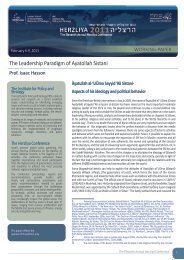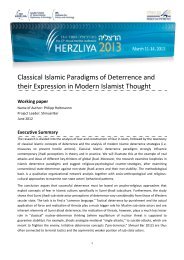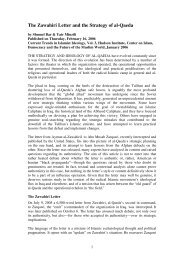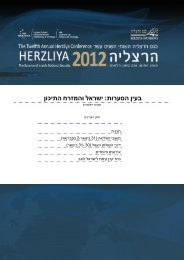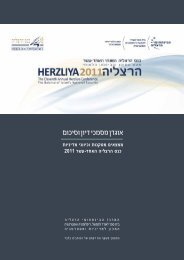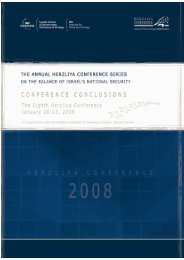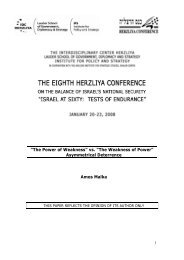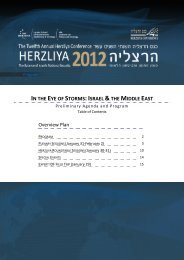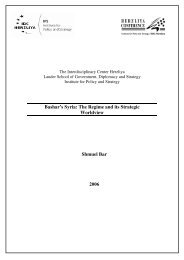Iran: Cultural Values, Self images and Negotiation Behavior
Iran: Cultural Values, Self images and Negotiation Behavior
Iran: Cultural Values, Self images and Negotiation Behavior
You also want an ePaper? Increase the reach of your titles
YUMPU automatically turns print PDFs into web optimized ePapers that Google loves.
<strong>Iran</strong>: <strong>Cultural</strong> <strong>Values</strong>, <strong>Self</strong>-<strong>images</strong> <strong>and</strong> Negotiating <strong>Behavior</strong>in whom outside <strong>and</strong> inside are the same. One of the principal themes of <strong>Iran</strong>ianliterature, films, <strong>and</strong> theater is the tension between the protagonist's internal morality<strong>and</strong> the seductive pull of the corrupting external world. The existence of the negativeexternal traits, however, are rationalized by attributing them to the corruptinginfluence of external forces; since these are the rules of the game in interaction withthese forces, the moral <strong>Iran</strong>ian has no choice but to play by them.Social StereotypesAlmost every ethnic group suffers from (or enjoys) stigmas <strong>and</strong> stereotypes – someself-inflicted. The Persian is no exception to this rule. Stereotypes <strong>and</strong> popularanecdotes told by <strong>Iran</strong>ians about themselves might to some extent have been seededby grains of truth, <strong>and</strong> in any case generate, in themselves, an accepted self-image. Inmany, the source of the stereotype (<strong>Iran</strong>'s Arab neighbors or the West) is reflected inthe cultural characteristics that the stereotype emphasizes. The following is an attemptto draw a composite sketch of the <strong>Iran</strong>ian drawn on the basis of these anecdotes <strong>and</strong>stereotypes.Two primary negative Persian stereotypes are those of the Mullah (the generic titleof the clergy, also Akhund or “singer” since the low ranking clergy would be hired tosing at funerals) <strong>and</strong> the Bazaari (a member of the merchant class that controls themarkets of the large cities). The two social classes are linked in popular negativestereotypes, as they are in the social system itself.The Mullah is stereotyped as corrupt, hypocritical, 12 avaricious, lascivious, 13argumentative, <strong>and</strong> unscrupulous – a person who exploits religion for the sake of hisown interests. <strong>Iran</strong>ian proverbs <strong>and</strong> folk sayings are replete with admonitions tobeware of the Mullah <strong>and</strong> not to trust him under any circumstance. 14 This image haseven found its way into the most popular of Persian poets, Hafez (fourteenth century),who wrote, “On the pulpit, preachers, goodness display/Yet in private, they have adifferent way. I have a question to ask of the learned in our midst/Why Confession-12Every <strong>Iran</strong>ian knows the story of the mullah, who on his way to the mosque for the morning prayerswas splashed by a dog shaking himself in a drainage ditch. The mullah, who knew he did not have timeto change his clothes, refused to look at the animal <strong>and</strong> rushed muttering “God willing, it is a goat.”This is short in Persian for “let things pass <strong>and</strong> don’t look at them closely.” It represents the agreementof the clerics to accept the boundaries between clean <strong>and</strong> unclean without being too finicky. Roy,Mottahadeh, The Mantle of the Prophet – Religion <strong>and</strong> Politics in <strong>Iran</strong> (New York: Pantheon Books,1985) 181.13 One Central Asian referent with wide experience in doing business with <strong>Iran</strong>ians repeated thefollowing maxim: to buy a haji, you need a glass of vodka, to buy a Hojat al-Islam, a whole bottle; anAyatollah costs two bottles <strong>and</strong> a pair of lovely legs, <strong>and</strong> an Ayatollah Ozma, more bottles <strong>and</strong> morelegs. His disdain for the moral rigidity of the entire class of clerics actually reflects a popular stigmaprevalent in countless reports on attitudes in <strong>Iran</strong> towards the clerical class, even before the Revolution.14 A common Persian anecdote tells of the Mullah who fell into a well but refuses to “give his h<strong>and</strong>” tothe villagers who came to save him. Only when one of the villagers said to him “take my h<strong>and</strong>” did theMullah extend his own, “because a mullah will never ‘give’ anything of his own… The Persian proverbstates “No one has seen the eye of an ant, the feet of a snake, or the charity of a Mullah.” SiminHabibian, 100 Persian–English Proverbs (Maryl<strong>and</strong>: Ibex, 1999) 94.6



